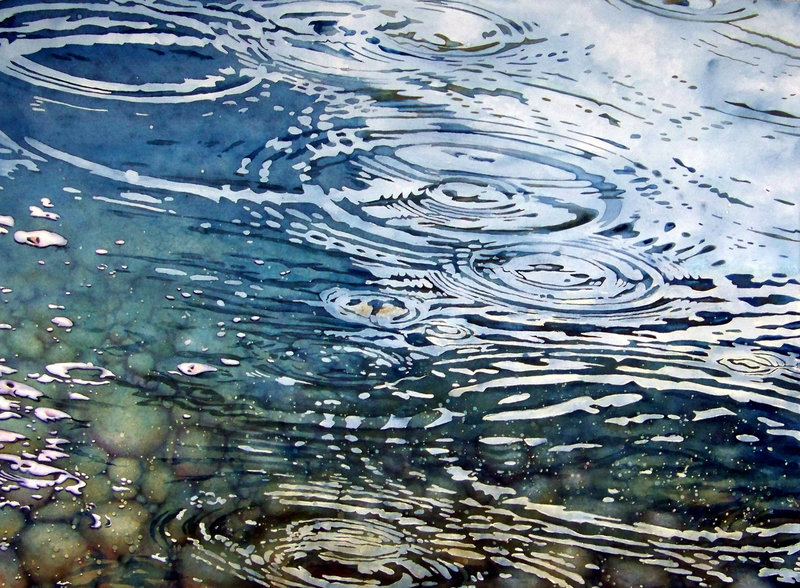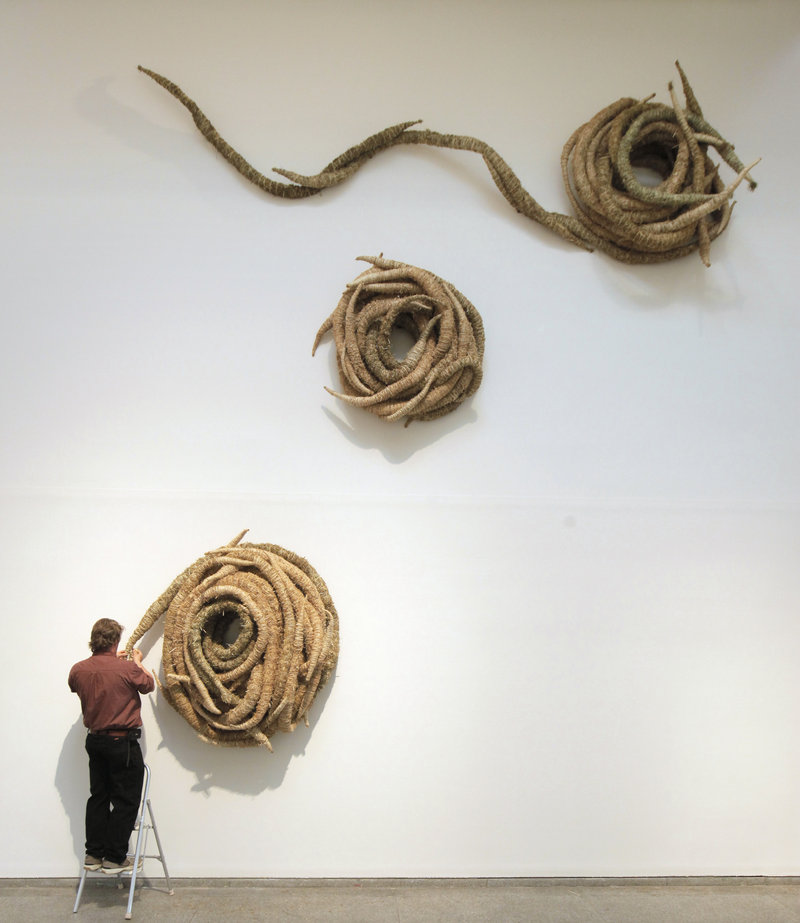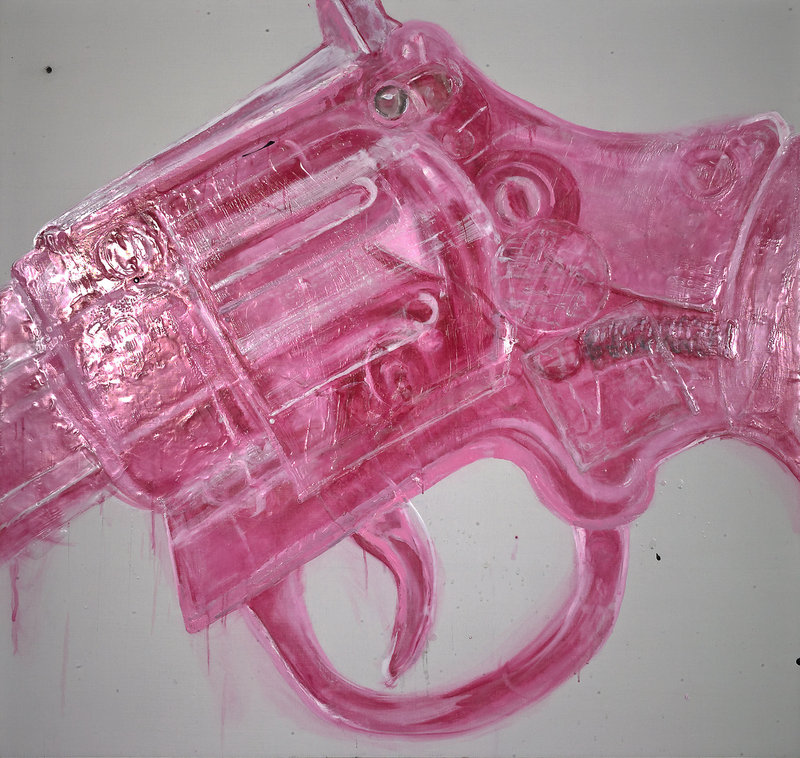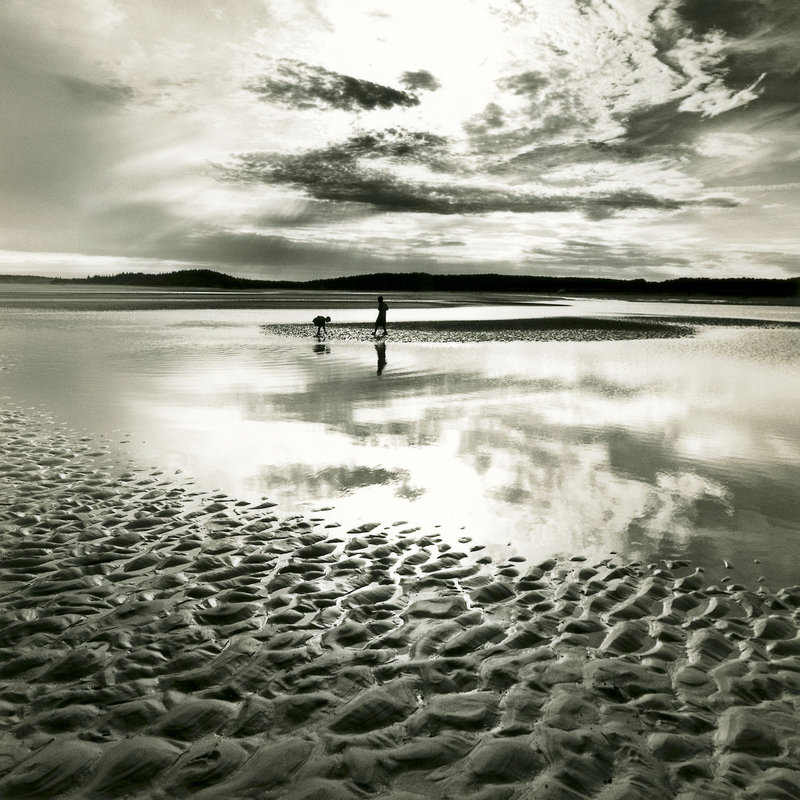PORTLAND — Welcome to the Barn, or the space usually known as the Great Hall.
For the 2011 Biennial, the Portland Museum of Art has seen its cavernous Great Hall turned into something of a gathering spot for farm animals. In a manner of speaking, of course.
Installation artist Michael Shaughnessy has adorned one wall of the hall with one of his signature sculptural pieces made almost entirely from hay and twine. This one, which Shaughnessy is calling “Cascade, Current and Pool,” is a nod to the vanquished falls of the Presumpscot River. The piece crawls, bends and twists up the wall, from bottom to top, and settles with a resounding sigh.
Its central feature is a series of tightly wound, 8-foot-long tails of hay, which are bound together in tight circles and allowed to open up and connect with other circular bundles higher up the wall.
The pieces feels almost like a slithering creature — up, up and away. Some might see it as an aerial view of a river with its tributaries and streams reaching across space like spidery veins.
It also smells. The pungent aroma of freshly cut hay is the first thing one notices upon entering the museum.
The Biennial opens Thursday and will remain on view through June 5. The Shaughnessy piece is one of 65 works of art chosen for the Biennial, which offers a snapshot of Maine’s contemporary art scene.
Most Biennial artists are full-time Mainers like Shaughnessy, who lives in Windham and teaches at the University of Southern Maine in Gorham. Many are part-timers, and others simply have deep Maine roots.
In all, 47 artists have work in the show.
ON A GRAND SCALE
Stylistically, the Biennial leans heavily on installations and photography. The previous Biennial, in 2009, featured three large-scale installations. This one has close to 10, said assistant curator Sage Lewis.
Several pieces cover entire walls, or large sections of them.
“That may be representative of one thing that the Biennial does well, which is to encourage artists to propose ambitious work for our spaces,” Lewis said.
It also continues a trend that has found artists daring to work with the museum’s architecture, particularly that of the Great Hall.
The Shaughnessy piece is the latest example, but there are many others, including Anna Hepler’s massive installation, “The Great Haul,” that almost filled the interior volume of the Great Hall last year, and Mark Wethli’s color-grid wall mural “Transom,” which began as a temporary Biennial piece many years ago and remains up today.
Photography has a large presence as well. That is not necessarily unusual; the Biennial always attracts a strong crop of photographers.
This year, there are more photographs than any other artistic medium and a tremendous range of photographic styles, including dye-infused metal prints, digital prints, traditional color prints and black-and-white.
Lewis said there are so many different kinds of photographs represented, the museum is preparing a glossary of terms to help viewers sort one from another.
The range of media is wide, and includes traditional landscape painting, drawing and printmaking, as well as video and installation.
SOMBER THEMES
A few themes emerge. Several artists tackle heavy ideas and difficult subjects.
Philip Brou returned to the hotel room where some of the 9/11 hijackers began their journey in South Portland, Brou’s home community. He sketched the room’s interior, made a rubbing of the door number, and created a diorama of the scene.
Gavin Rouille made a memorial to transgendered victims of hate crimes in the United States, and William Cox, a photographer, created a series of portraits of people who inflict self-harm by cutting themselves.
“For the Trees” by Avy Claire is a series of drawings of trees on see-through mylar. When one looks closely, one notices that she made the trees by drawing tiny words and phrases transcribed from news programs that she was listening to in her studio. She wrote down what she heard on the radio and soothed her anxieties by creating a peaceful, inviting forest scene.
Natasha Bowdoin, a 29-year-old artist and Maine native now living in Texas, spent much of last week laboring over her large, wall-size installation, “Untitled (Alice).”
On top of a painted backdrop, she hangs hand-cut drawings that document her transcription of Lewis Carroll’s “Alice’s Adventure in Wonderland” and “Through the Looking-Glass.”
“The idea is that people can take this text and read their own way through it,” she said. “I am trying to animate the stories that I choose to work with in a different way than in a book.”
Bowdoin decided to submit work for the Biennial because she is from Maine and has always wanted to show here. The Biennial seemed like an appropriate venue.
“I really wanted the opportunity to show my family and my friends what I have been up to,” she said. “I’ve never really shown my work in Maine before. But since I’m from here, I thought, ‘I should be doing this.’ So I submitted.”
This year’s jurors were Jim Kempner, owner and director of Jim Kempner Fine Art in New York; David Row, a painter based in New York and Maine; and Joanna Marsh, a curator of contemporary art at the Smithsonian American Art Museum in Washington, D.C.
They reviewed more than 900 applicants, choosing 65 works from 47 artists.
Staff Writer Bob Keyes can be contacted at 791-6457 or at:
bkeyes@pressherald.com
Follow him on Twitter at:
twitter.com/pphbkeyes
Copy the Story Link
Send questions/comments to the editors.








Success. Please wait for the page to reload. If the page does not reload within 5 seconds, please refresh the page.
Enter your email and password to access comments.
Hi, to comment on stories you must . This profile is in addition to your subscription and website login.
Already have a commenting profile? .
Invalid username/password.
Please check your email to confirm and complete your registration.
Only subscribers are eligible to post comments. Please subscribe or login first for digital access. Here’s why.
Use the form below to reset your password. When you've submitted your account email, we will send an email with a reset code.